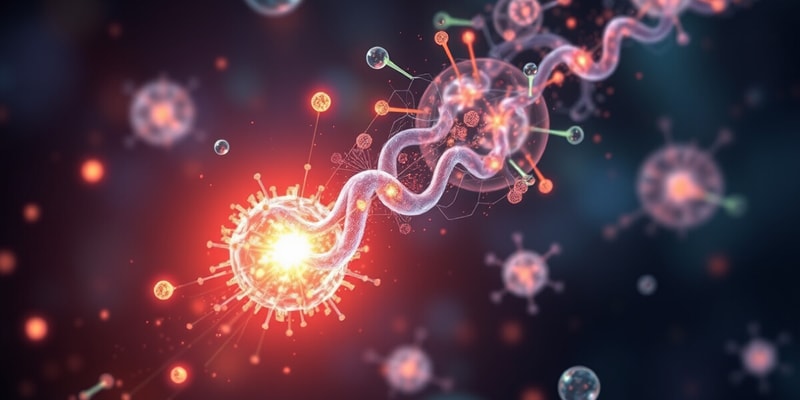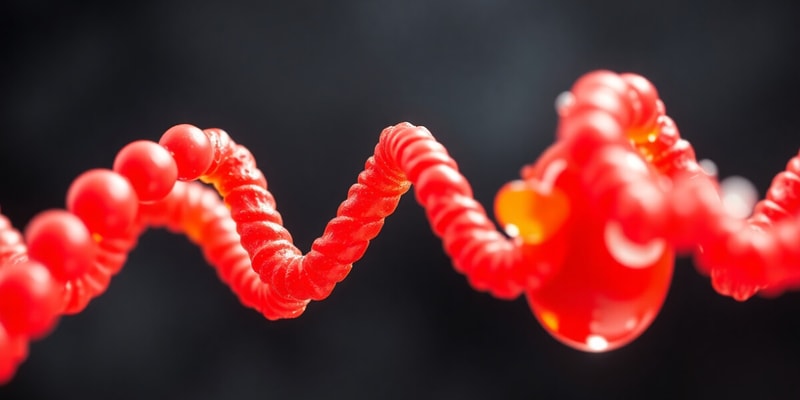Podcast
Questions and Answers
The Gibbs free energy change ($, riangle G$) for the reaction ATP → ADP + Pi is equal to $-30.5$ kJ mol−1.
The Gibbs free energy change ($, riangle G$) for the reaction ATP → ADP + Pi is equal to $-30.5$ kJ mol−1.
True
The enthalpy change ($ riangle H$) for the reaction ATP → ADP + Pi is $+20.1$ kJ mol−1.
The enthalpy change ($ riangle H$) for the reaction ATP → ADP + Pi is $+20.1$ kJ mol−1.
False
A positive change in entropy ($ riangle S$) indicates a decrease in disorder in the system.
A positive change in entropy ($ riangle S$) indicates a decrease in disorder in the system.
False
For the unfolding of a protein to occur spontaneously, the Gibbs free energy ($ riangle G$) must be greater than zero.
For the unfolding of a protein to occur spontaneously, the Gibbs free energy ($ riangle G$) must be greater than zero.
Signup and view all the answers
The change in entropy for the reaction ATP → ADP + Pi at 37 °C is calculated to be $34.0$ J K−1 mol−1.
The change in entropy for the reaction ATP → ADP + Pi at 37 °C is calculated to be $34.0$ J K−1 mol−1.
Signup and view all the answers
If $ riangle S°$ for a reaction is negative, it promotes spontaneity at higher temperatures.
If $ riangle S°$ for a reaction is negative, it promotes spontaneity at higher temperatures.
Signup and view all the answers
For the unfolding of a protein where $ riangle H° = 250.8$ kJ mol−1 and $ riangle S° = 752$ J K−1 mol−1, the process becomes spontaneous above a certain temperature.
For the unfolding of a protein where $ riangle H° = 250.8$ kJ mol−1 and $ riangle S° = 752$ J K−1 mol−1, the process becomes spontaneous above a certain temperature.
Signup and view all the answers
A reaction with a negative enthalpy change ($ riangle H$) always has a negative Gibbs free energy change ($ riangle G$).
A reaction with a negative enthalpy change ($ riangle H$) always has a negative Gibbs free energy change ($ riangle G$).
Signup and view all the answers
The temperature at which the reaction transitioning from ATP to ADP becomes spontaneous can be found using the equation $ riangle G = riangle H - T riangle S$.
The temperature at which the reaction transitioning from ATP to ADP becomes spontaneous can be found using the equation $ riangle G = riangle H - T riangle S$.
Signup and view all the answers
The values $ riangle H° = 250.8$ kJ mol−1 and $ riangle S° = 752$ J K−1 mol−1 indicates that unfolding a protein is always spontaneous.
The values $ riangle H° = 250.8$ kJ mol−1 and $ riangle S° = 752$ J K−1 mol−1 indicates that unfolding a protein is always spontaneous.
Signup and view all the answers
The change in Gibbs free energy ($\Delta G$) for the reaction ATP → ADP + Pi is positive at 37 °C.
The change in Gibbs free energy ($\Delta G$) for the reaction ATP → ADP + Pi is positive at 37 °C.
Signup and view all the answers
A reaction with a negative change in enthalpy ($\Delta H$) and a positive change in entropy ($\Delta S$) always has a negative Gibbs free energy ($\Delta G$) at all temperatures.
A reaction with a negative change in enthalpy ($\Delta H$) and a positive change in entropy ($\Delta S$) always has a negative Gibbs free energy ($\Delta G$) at all temperatures.
Signup and view all the answers
For the unfolding of the protein to be spontaneous, the temperature must be lower than 250.8 °C.
For the unfolding of the protein to be spontaneous, the temperature must be lower than 250.8 °C.
Signup and view all the answers
A positive change in entropy ($\Delta S$) for a reaction indicates a decrease in disorder of the system.
A positive change in entropy ($\Delta S$) for a reaction indicates a decrease in disorder of the system.
Signup and view all the answers
The calculated change in entropy ($\Delta S$) for the reaction ATP → ADP + Pi is 34.0 kJ mol−1.
The calculated change in entropy ($\Delta S$) for the reaction ATP → ADP + Pi is 34.0 kJ mol−1.
Signup and view all the answers
The unfolding of a protein occurs spontaneously when the system's Gibbs free energy ($\Delta G$) is less than zero.
The unfolding of a protein occurs spontaneously when the system's Gibbs free energy ($\Delta G$) is less than zero.
Signup and view all the answers
If a reaction has a positive change in Gibbs free energy ($\Delta G$), it can still proceed if energy is supplied.
If a reaction has a positive change in Gibbs free energy ($\Delta G$), it can still proceed if energy is supplied.
Signup and view all the answers
The reaction ATP → ADP + Pi is an example of a process that increases the number of molecules in the system, hence increasing disorder.
The reaction ATP → ADP + Pi is an example of a process that increases the number of molecules in the system, hence increasing disorder.
Signup and view all the answers
The threshold temperature for protein unfolding, calculated from given thermodynamic values, is influenced directly by changes in enthalpy ($\Delta H$) and entropy ($\Delta S$).
The threshold temperature for protein unfolding, calculated from given thermodynamic values, is influenced directly by changes in enthalpy ($\Delta H$) and entropy ($\Delta S$).
Signup and view all the answers
An increase in temperature always leads to an increase in the Gibbs free energy ($\Delta G$) of a reaction.
An increase in temperature always leads to an increase in the Gibbs free energy ($\Delta G$) of a reaction.
Signup and view all the answers
Study Notes
Gibbs Free Energy Equation Explanation
-
The Gibbs Free Energy equation is written as: G = H − TS
-
G : Gibbs free energy, a measure of the spontaneity of a reaction. A negative G indicates a spontaneous reaction, while a positive G indicates a non-spontaneous reaction.
-
H : Enthalpy change, a measure of the heat flow during a reaction.
-
T : Temperature in Kelvin.
-
S : Entropy change, a measure of the disorder of a system; a positive S indicates increased disorder, while a negative S indicates decreased disorder.
Calculating Entropy Change (S) in ATP Hydrolysis
-
The hydrolysis of ATP (adenosine triphosphate) to ADP (adenosine diphosphate) and inorganic phosphate (Pi) is a key energy-releasing process in biological systems.
-
Given:
- G° (standard Gibbs free energy) = -30.5 kJ mol-1
- H° (standard enthalpy change) = -20.1 kJ mol-1
- Temperature = 37°C (which should be converted to Kelvin, 37 + 273 = 310 K)
-
Calculate S° using the equation G = H − TS
-
Rearrange the equation to solve for S°:
- S° = (H° - G°) / T
- S° = (-20.1 kJ mol-1 - (-30.5 kJ mol-1)) / 310 K
- S° = 10.4 kJ mol-1 / 310 K
- S° = 0.034 kJ mol-1 K (or 34 J mol-1 K)
Significance of Enthalpy (H), Entropy (S) and Gibbs Free Energy (G) in ATP Hydrolysis
-
- Enthalpy (H): The enthalpy change is negative (-20.1 kJ mol-1), indicating an exothermic process (heat is released). This is likely due to the formation of new bonds, such as the P-O bond in inorganic phosphate (Pi).
-
Entropy (S): The entropy change is positive (+34 J mol-1 K), indicating an increase in disorder or randomness. This is expected as one molecule (ATP) is broken down into two molecules (ADP and Pi).
-
Gibbs Free Energy (G): The Gibbs free energy change is negative (-30.5 kJ mol-1), indicating a spontaneous reaction under these conditions. This means at 37 °C, the hydrolysis of ATP is favorable and will tend to proceed towards the formation of ADP and Pi. The negative value of G also indicates that the ATP hydrolysis is an exergonic process, releasing free energy that can be used to drive other cellular processes.
Spontaneous Protein Unfolding: Effect of Temperature on G
-
The unfolding of a protein is described as a process where a folded, active protein transitions to an unfolded, inactive state.
-
The enthalpy change (H°) for protein unfolding is positive (+250.8 kJ mol-1), meaning the process requires energy input (endothermic). This is because breaking the interactions that maintain the folded structure requires energy.
-
The entropy change (S°) for protein unfolding is also positive (+752 J K−1 mol −1), indicating an increase in disorder as the protein unfolds and becomes less structured.
-
The temperature at which the protein unfolding becomes spontaneous (i.e., G becomes negative) is determined by the balance between enthalpy and entropy.
Determining the Temperature for Spontaneous Protein Unfolding
-
For unfolding to be spontaneous (favorable), the G must be negative:
-
To find the critical temperature where the reaction switches to spontaneity, we need to find the temperature at which G = 0.
-
Using the equation G = H − TS, and setting G to 0:
- 0 = H - TS
- 0 = 250.8 kJ mol-1 - T (0.752 kJ K-1 mol-1)
- T = 250.8 kJ mol-1 / 0.752 kJ K-1 mol-1
- T = 333.6 K
-
Converting this temperature back to Celsius:
- T = 333.6 K - 273.15 K = 60.45 °C
-
Therefore, protein unfolding becomes spontaneous (favorable) above 60.45 °C.
Commentary on the Significance of the Values of H, S, and G
-
The positive enthalpy of protein unfolding (H°) reflects that unfolding requires energy input and is an endothermic process.
-
The positive entropy change (S°) reflects that unfolding leads to an increase in disorder within the protein structure.
-
The temperature at which unfolding becomes spontaneous is dependent on the interplay between the thermodynamic parameters of the reaction (enthalpy and entropy). At temperatures below 60.45°C, the enthalpy term (favorable for folded state) dominates, keeping the protein folded. However, at temperatures above 60.45 °C, the entropic term (favorable for unfolded state) dominates, promoting unfolding.
Gibbs Free Energy
- The Gibbs Free Energy (ΔG) determines the spontaneity of a reaction.
- A negative ΔG value indicates a spontaneous reaction (favors product formation), while a positive ΔG value indicates a non-spontaneous reaction (favors reactants).
- ΔG is related to enthalpy change (ΔH) and entropy change (ΔS) by the equation: ΔG = ΔH - TΔS
- Enthalpy (ΔH) is the heat absorbed or released during a reaction.
- A negative ΔH value indicates an exothermic reaction (heat released).
- A positive ΔH value indicates an endothermic reaction (heat absorbed).
- Entropy (ΔS) measures the disorder or randomness of a system.
- A positive ΔS value indicates an increase in disorder.
- A negative ΔS value indicates a decrease in disorder.
ATP Hydrolysis
- The hydrolysis of ATP (adenosine triphosphate) to ADP (adenosine diphosphate) and inorganic phosphate (Pi) is a highly exergonic reaction.
- ΔG° for this reaction is -30.5 kJ/mol, indicating that it releases energy and is spontaneous under standard conditions.
- The enthalpy change (ΔH°) for ATP hydrolysis is -20.1 kJ/mol, indicating that the reaction releases heat.
- Calculating the entropy change (ΔS°) at 37 °C using the equation ΔG = ΔH - TΔS, we get 34.0 J/mol.
- The positive ΔS value indicates an increase in disorder during ATP hydrolysis, likely because one molecule is breaking down into two smaller molecules.
Protein Unfolding
- The unfolding of a protein is an endothermic process (ΔH° = 250.8 kJ/mol) where the protein absorbs heat.
- Unfolding also increases the entropy (ΔS° = 752 J/K/mol) due to a decrease in structural order in the protein.
- The protein will unfold spontaneously when the Gibbs free energy is negative, favoring the unfolded state.
- This occurs at temperatures exceeding the point where ΔG is zero.
- The temperature at which unfolding becomes spontaneous is calculated using ΔG = ΔH - TΔS and setting ΔG to zero.
Temperature Dependence of Spontaneity
- Protein unfolding is favored at higher temperatures because the entropic contribution of the unfolded state becomes more dominant.
- This can be seen in the equation ΔG = ΔH - TΔS as the negative temperature term (TΔS) becomes larger at higher temperatures.
- When the temperature increases, the entropic term (TΔS) becomes greater than the enthalpic term (ΔH), making the Gibbs free energy negative and favoring the unfolded state.
- This illustrates that the spontaneity of a reaction can depend on temperature.
Studying That Suits You
Use AI to generate personalized quizzes and flashcards to suit your learning preferences.
Related Documents
Description
Test your understanding of the Gibbs Free Energy equation and its application in ATP hydrolysis. This quiz covers key concepts, including the significance of enthalpy and entropy changes during reactions. Explore how these thermodynamic principles relate to spontaneity and energy transfer in biological systems.




